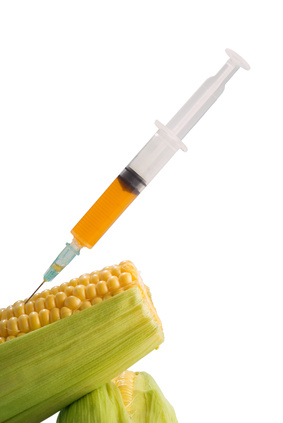
By Julie Gengo, HealthWalk™ Marketing Coordinator
I remember watching a PBS documentary in 2001 called Harvest of Fear. This 2-hour special on genetically-modified (GM) foods thoroughly presented potential dangers to this planet and its inhabitants alike when and if these crops were allowed to grow in abundance. After seeing this, I was certain that our government and its agencies (FDA, USDA, EPA, Dept. of Agriculture) would prohibit rapid expansion and provide adequate testing of each new item. I also thought that if Americans knew of these dangers that we would follow our European counter parts in banning GM crops and banning together to not allow ‘Frankenfoods’ into our food chain.
As it turns out, most people didn’t see this documentary, in fact eight years later, many people are not aware of what a genetically modified organism (GMO) is; what foods are involved in this technology; and how harmful it is to the planet and our bodies. Since this documentary aired, within the U.S., 81-86%of all corn, 88-90% of all soybean and 81-93% of all upland cotton are GM crops. That is an astounding amount considering what we now know about the ramifications to the environment and the negative health effects these crops have posed. In addition to soybeans, cotton and corn, rice, sugar beets, canola, and potatoes are also among the predominant GM crop planted in the U.S. and Canada.
What are GMOs and GM Foods?
From Wikipedia: “a genetically modified organism (GMO) or genetically engineered organism (GEO) is an organism whose genetic material has been altered using genetic engineering techniques.” The environmental organization, Environmental Commons explains, “genetic engineering is a process whereby genes from one organism are moved into the genome of another organism. In the case of genetically engineered foods, genes from bacteria or other plants or other organisms are moved into crop varieties with the assistance of a viral vector. This provides herbicide-tolerance and/or insect resistance to existing domesticated plant varieties. In many cases, biotechnology breaks down natural species boundaries. The genes inserted cannot be removed and thus become released into the environment during the pollination process.”
In other words, the DNA within seeds is spliced and inserted with other genes that serve a specific purpose. For instance, a common gene used is the family of toxin proteins derived from the bacterium Bacillus thuringiensis (Bt) that is resistant to glyphosphate (a pesticide more commonly known as Roundup made by Monsanto). This gene creates a plant that is ‘Roundup Ready’ or Roundup resistant. When the pesticide is sprayed on the plant, the plant is unscathed however the surrounding weeds die thus reducing production costs and creating higher yields. In theory, the use of this pesticide would diminish, as the plant would also have a natural ability to fight off the insects.
Invasion of Superweeds, Superbugs and Superbacteria:
Unfortunately what was predicted back in the early days of GM experimentation failed to materialize. Weeds have become superweeds. Due to unavoidable cross-pollination, these weeds have absorbed the same GM genes also becoming resistant to Roundup.
Because of these superweeds, the use of pesticides has actually gone up so much so that in the United States critics suggest that the regulatory agency that monitors for effects on the quality of life due to pesticide use has lost its power to test for levels of pesticides in foods, damage to the environment and to the public. This regulation was quietly removed from the Department of Agriculture’s jurisdiction in 2008 for so-called budgetary reasons. According to an article posted in the Chicago Times: “The Bush administration has abruptly halted a government program that tests the levels of pesticides in fruits, vegetables and field crops, arguing that the $8 million-a-year program is too expensive — a decision critics say could make it harder to protect consumers from chemicals in their food. Data from the 18-year-old Agricultural Chemical Usage Program administered by the U.S. Department of Agriculture were collected until this year, and the Environmental Protection Agency used the data to set safe levels of pesticides in food.”
Insects and bacteria have also become super-resistant requiring a significant increase in the amounts of insecticides into the environment and into our bodies.
What Foods Contain GM Ingredients?
Major brands such as Nabisco®, Frito-Lay®, Proctor & Gamble, and Kraft® are using genetically engineered byproducts. In fact, most major brands including private label brands of bread, crackers, cereals, canned soups or frozen dinners contain GM ingredients. And to protect the chemical companies that create these foods, the U.S. government has allowed genetically modified organisms to be released into our food supply without adequate labeling or testing.
GM and GMO Testing and Regulation:
A report prepared by Brian Tokar for the Institute for Social Ecology Biotechnology Project in June 2006 finds that “no federal laws have been passed to specifically regulate genetically-engineered crops. Since 1986, responsibility for GE foods and crops has been divided among three federal agencies (USDA-APHIS, EPA, FDA), based upon preexisting statutes.” These statues are antiquated and offer no regulation for protection or scrutiny to the public and environment.
GM Food Safety
What is most astonishing from Toker’s report is that “GE crops are only subject to “voluntary consultations” with companies who choose to consult with the agency about their products. Because the consultations are voluntary, FDA does not specify a required list of studies or test methods, but instead accepts superficial in-house summaries of whatever testing the company has chosen to do. FDA requests for additional data sometimes go unfulfilled.”
In essence, we humans have been the testing sites or guinea pigs for Frankenfoods. Since introduction of GMOs into the marketplace in 1996, numerous studies have since shown significant negative and toxic effects of ingesting GM ingredients as well as being exposed to increased amounts of pesticides, herbicides and insecticides.
In a 2001 article entitled: “Townsend Letter for Doctors and Patients – Health Concerns & GMO Food; genetically modified” by Jule Klotter, one of the most common problems is newly developed allergins to foods once deemed low on the allergy list. The FDA has concluded: “Genetic engineering may transfer new and unidentified proteins from one food into another, triggering allergic reactions. Millions of Americans who are sensitive to allergens will have no way of identifying or protecting themselves from offending foods. Allergic reactions can cause more than simple discomfort — they can result in life-threatening anaphylactic shock.” As an example, Trypsin-inhibitor, a major allergen with anti-nutritional effects, was 26.7% higher in Monsanto’s RR soybeans. The York Nutritional Laboratory, which specializes in food sensitivity, reported a 50% increase in soy allergies in 1999-2000.
Klotter also discloses that soybeans aren’t the only problem as scientists have also found that genetically-engineered potatoes have caused “significant damage” to rats among other genetically-engineered food crops.
The Institute for Responsible Technology has published a comprehensive pamphlet, Unintended GMO Health Risks, which sums up the reasons why we should avoid GM foods: They have been linked to thousands of toxic and allergenic reactions, thousands of sick, sterile, and dead livestock, and damage to virtually every organ and system studied in lab animals.” The guide briefly outlines information on allergic reactions to GM foods as well as liver and reproductive problems, sterility, disease, death and even infant mortality linked to GMO consumption.
The evidence is overwhelmingly in favor of reducing and eliminating GM foods from your diet. The good news is that organic foods do not contain GMOs, pesticides, herbicides, insecticides, fungicides and other toxic elements that are proven to harm the body.













![GreenWithEnvy[1]](https://naturallygreen.wordpress.com/wp-content/uploads/2009/12/greenwithenvy1.jpg?w=300&h=86)
![carlee[1]](https://naturallygreen.wordpress.com/wp-content/uploads/2009/12/carlee1.jpg?w=205&h=300)
![Lila_&_Ben_045[1]](https://naturallygreen.wordpress.com/wp-content/uploads/2009/12/lila__ben_0451.jpg?w=300&h=200)
![Lila_&_Ben_678[1]](https://naturallygreen.wordpress.com/wp-content/uploads/2009/12/lila__ben_6781.jpg?w=300&h=200)





 Well, unfortunately the EPA is doing a lousy job at setting and enforcing regulation that serves our society’s best interest. What is most disturbing is that there are no mandates only recommendations, that protect school children, a segment of our population that is most vulnerable to environmental toxins.
Well, unfortunately the EPA is doing a lousy job at setting and enforcing regulation that serves our society’s best interest. What is most disturbing is that there are no mandates only recommendations, that protect school children, a segment of our population that is most vulnerable to environmental toxins.
 EcoSmart maker of a line of organic pest control products both for home and commercial use is an excellent option when choosing an alternative. These products are not only safe to use but also smell incredibly delightful so much so that they block out any foul odor lingering about. They wreak of winter-mint and other natural scents that have pleasing effects. Can you recall any bug spray that you could actually hang out in a room with immediately after using?
EcoSmart maker of a line of organic pest control products both for home and commercial use is an excellent option when choosing an alternative. These products are not only safe to use but also smell incredibly delightful so much so that they block out any foul odor lingering about. They wreak of winter-mint and other natural scents that have pleasing effects. Can you recall any bug spray that you could actually hang out in a room with immediately after using?


 RSS Feed this blog
RSS Feed this blog